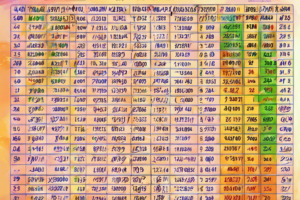Introduction:
Learning the names of Hindi months is a great way to deepen your understanding of Indian culture and language. In Hindi, the months are called “Mahine”, and each month holds significance in various festivals and traditions. In this comprehensive guide, we will delve into the names of the Hindi months, their significance, and how they align with the traditional lunar calendar.
Understanding the Hindi Months:
The Hindi calendar follows the traditional lunar calendar, which is based on the cycles of the moon. Each month typically begins with the new moon and consists of either 29 or 30 days. The names of the months in Hindi are deeply rooted in Indian culture, history, and mythology. Let’s explore the names of the Hindi months and their significance:
1. Chaitra (चैत्र):
Chaitra is the first month of the Hindu calendar. It marks the beginning of the new year in many regions of India, especially in North India. The month of Chaitra is associated with the festival of Navratri and the Hindu New Year celebrations.
2. Vaisakha (वैशाख):
Vaisakha is the second month of the Hindi calendar and is considered auspicious for Hindu marriages and religious ceremonies. It is also the month of the Baisakhi festival celebrated with great enthusiasm in North India.
3. Jyaistha (ज्येष्ठ):
Jyaistha is the third month of the Hindi calendar and is associated with the summer season. It is a time for harvest festivals and agricultural activities in many parts of India.
4. Asadha (आषाढ़):
Asadha is the fourth month in the Hindi calendar and marks the beginning of the monsoon season in India. It is a time of rejuvenation and new beginnings after the scorching summer heat.
5. Shravana (श्रावण):
Shravana is the fifth month of the Hindi calendar and is considered highly auspicious for devotional activities and prayers. It is the month of the famous Shravan Somvar Vrat observed by devotees of Lord Shiva.
6. Bhadrapada (भाद्रपद):
Bhadrapada is the sixth month in the Hindi calendar and is associated with various festivals such as Ganesh Chaturthi and Onam. It is a month of celebration and devotion to deities.
7. Ashvin (आश्विन):
Ashvin is the seventh month of the Hindi calendar and is known for the Navratri festival and Durga Puja celebrated with zeal across India. It heralds the arrival of the festive season.
8. Kartika (कार्तिक):
Kartika is the eighth month in the Hindi calendar and holds immense religious significance for Hindus. It is the month of Diwali, the festival of lights, and various rituals dedicated to Lord Vishnu and Lord Shiva.
9. Agrahayana (अग्रहायण):
Agrahayana is the ninth month of the Hindi calendar and is associated with winter, harvesting, and religious ceremonies. It is a time of feasting and celebrations leading up to the new year.
10. Pausha (पौष):
Pausha is the tenth month in the Hindi calendar and is a time for spiritual reflection and introspection. It is a month of festivals like Makar Sankranti celebrated with kite flying and sweet delicacies.
11. Magha (माघ):
Magha is the eleventh month of the Hindi calendar and is considered auspicious for holy dips in rivers during the Magha Purnima. It is a month of charity and devotional offerings.
12. Phalguna (फाल्गुन):
Phalguna is the twelfth and final month in the Hindi calendar and is associated with the festival of colors, Holi. It is a time of joy, celebration, and renewal as people come together to play with colors.
Frequently Asked Questions (FAQs):
1. How do the Hindi months differ from the English months?
The Hindi months are based on the traditional lunar calendar and have different names and start dates compared to the Gregorian calendar used in English-speaking countries.
2. Are the Hindi months strictly followed for festivals and auspicious occasions?
Yes, the Hindi months play a significant role in determining festival dates and auspicious times for ceremonies in Hindu culture.
3. How do the Hindi months influence agricultural practices in India?
The Hindi months are closely tied to agricultural seasons, guiding farmers in sowing, harvesting, and other agricultural activities.
4. Can one celebrate festivals based on the English months instead of the Hindi months?
While it is possible to celebrate festivals based on the English calendar, adhering to the Hindi months adds cultural authenticity and significance to the celebrations.
5. Are there regional variations in the names and significance of the Hindi months?
Yes, there are regional variations in the names and traditions associated with the Hindi months across different states in India.
6. Can non-Hindi speakers also learn and use the names of the Hindi months?
Absolutely! Learning the names of the Hindi months can be a fun and enriching experience for non-Hindi speakers interested in Indian culture and traditions.
7. How can one learn more about the significance of each Hindi month?
Reading Hindu calendars, attending festivals, and exploring Indian mythology are great ways to deepen your understanding of the significance of each Hindi month.
Conclusion:
Understanding the names and significance of the Hindi months provides a unique insight into Indian culture, traditions, and the rhythm of life in the subcontinent. By immersing ourselves in the Hindi calendar, we can not only appreciate the rich tapestry of festivals and rituals but also connect with the essence of time as perceived in Indian ethos. Embrace the diversity of the Hindi months and let their cultural resonance enrich your journey into the heart of India.



